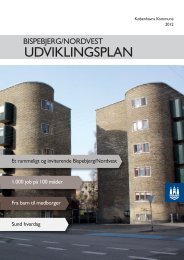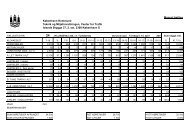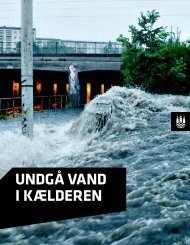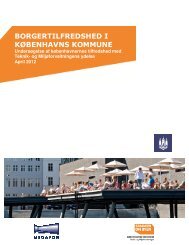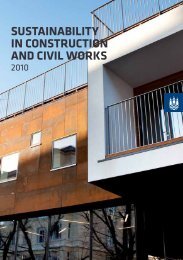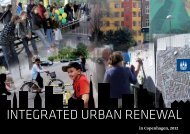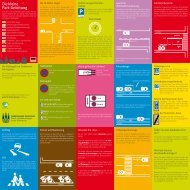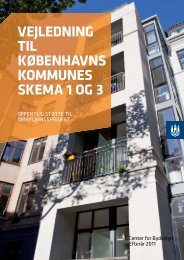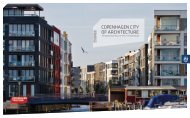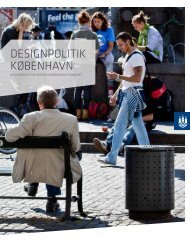The City of Copenhagen's Bicycle Strategy 2011-2025
The City of Copenhagen's Bicycle Strategy 2011-2025
The City of Copenhagen's Bicycle Strategy 2011-2025
Create successful ePaper yourself
Turn your PDF publications into a flip-book with our unique Google optimized e-Paper software.
Good, Better, Best<br />
<strong>The</strong> <strong>City</strong> <strong>of</strong> Copenhagen’s<br />
<strong>Bicycle</strong> <strong>Strategy</strong> <strong>2011</strong>-<strong>2025</strong>
Published <strong>2011</strong> by<br />
<strong>The</strong> <strong>City</strong> <strong>of</strong> Copenhagen<br />
Technical and Environmental Administration<br />
Traffic Department<br />
www.kk.dk/city<strong>of</strong>cyclists<br />
Visualisations and Graphic Design<br />
Goodmorning Technology, LOTS Design, Public Arkitekter,<br />
Cobe, DISSING+WEITLING architecture A/S, Visualization<br />
Studio Olafur Eliasson and TMF Graphic Design<br />
Photos<br />
Troels Heien, Chr. Alsing<br />
Additional photos<br />
<strong>The</strong> <strong>City</strong> <strong>of</strong> Copenhagen<br />
Copenhagen Museum<br />
Translation<br />
Copenhagenize Consulting<br />
COPENHAGENERS<br />
CYCLE<br />
And they always have.<br />
Conversation cycling on<br />
Dr. Louises Bro in the 1930s.
FROM GOAL<br />
TO REALITY<br />
COPENHAGEN MUST BECOME THE WORLD’S<br />
BEST BICYCLE CITY!<br />
Number <strong>of</strong> bicycle trips<br />
240,000<br />
<strong>2025</strong><br />
<strong>The</strong> goal was firmly set by a unanimous city council as an<br />
integral part <strong>of</strong> the vision <strong>of</strong> Copenhagen as an Environmental<br />
Capital. Above par conditions for cycling are also an important<br />
element in Copenhagen’s goal <strong>of</strong> having a good city life and<br />
making Copenhagen C02 neutral by <strong>2025</strong>. Good conditions for<br />
cycling are also part <strong>of</strong> the city’s <strong>of</strong>ficial health policy.<br />
200,000<br />
160,000<br />
2010<br />
In other words, cycling is not a goal in itself but rather a highlyprioritised<br />
political tool for creating a more liveable city.<br />
Copenhagen is already a fine bicycle city. Every single morning<br />
hundreds <strong>of</strong> thousands <strong>of</strong> Copenhageners choose the bicycle as the<br />
most natural thing in the world. It is amazing to many foreigners<br />
and the source <strong>of</strong> great interest for journalists, researchers,<br />
politicians and urban planners from every corner <strong>of</strong> the world.<br />
120,000<br />
80,000<br />
40,000<br />
1970<br />
NUMBER OF BICYCLE TRIPS TO/FROM THE INNER<br />
CITY FROM 6:00 AM TO 6:00 PM ON WEEKDAYS<br />
Copenhagen’s plan for achieving a greater modal share for bicycles<br />
includes increasing the capacity <strong>of</strong> the cycle tracks to the city centre,<br />
in order to accommodate an additional 60,000 cyclists by <strong>2025</strong>.<br />
Copenhagen couldn’t have achieved this status without a<br />
steady and comprehensive effort. Cycling in Denmark has<br />
fallen by 30% since 1990. <strong>The</strong> numbers for Copenhagen,<br />
however, head in the opposite direction. <strong>The</strong> number <strong>of</strong><br />
kilometres cycled has risen by around 30% since 1998 and<br />
the bicycle’s modal share for trips to work or educational<br />
institutions has risen to over a third in the same period.<br />
This makes the bicycle the most popular transport form for<br />
commuting in Copenhagen.<br />
<strong>The</strong> goal <strong>of</strong> this publication is to highlight, with the help <strong>of</strong><br />
words, numbers and photos, what is required if Copenhagen<br />
is to reach its ambitious goal <strong>of</strong> increasing the modal share for<br />
bicycles. Not to mention making the city more bicycle-friendly.<br />
In other words, how we can take Copenhagen to the next level as<br />
a bicycle city. From good to better and on to the best in the world.<br />
This bicycle strategy replaces the municipality’s former<br />
bicycle strategy “Cycle Policy 2002-2012”.<br />
Enjoy the read!<br />
Best regards,<br />
Ayfer Baykal<br />
Mayor <strong>of</strong> Technical and Environmental Administration<br />
On behalf <strong>of</strong> the Technical and Environmental Committee<br />
4<br />
5
36%<br />
<strong>of</strong> all trips to work or educational<br />
institutions in Copenhagen are by bicycle,*<br />
equalling 0 tonnes <strong>of</strong> C02 emissions.<br />
This high percentage <strong>of</strong> the modal share is<br />
a key element in the declared goal <strong>of</strong> making<br />
Copenhagen<br />
CO2-neutral<br />
by <strong>2025</strong><br />
*Average 2008-2010<br />
A BETTER<br />
BICYCLE CITY<br />
A MORE<br />
LIVEABLE<br />
CITY<br />
6<br />
A bicycle-friendly city is a city with more space, less noise,<br />
cleaner air, healthier citizens and a better economy. It’s a city<br />
that is a nicer place to be in and where individuals have a<br />
higher quality <strong>of</strong> life. Where accessibility is high and there is<br />
a short route from thought to action if one wants to head out<br />
into nature, participate in cultural or sports activities or buy<br />
locally. <strong>Bicycle</strong> traffic is therefore not a singular goal but rather<br />
an effective tool to use when creating a liveable city with space<br />
for diversity and development.<br />
Fortunately, it pays <strong>of</strong>f to invest in urban cycling. Increased<br />
cycling levels give society less congestion, fewer sick days,<br />
longer life expectancy, less wear and tear on the roads and less<br />
pollution. Cycling initiatives are also inexpensive compared<br />
with other transport investments.<br />
<strong>The</strong> eyes <strong>of</strong> the world are already focused on Copenhagen – <strong>The</strong><br />
<strong>City</strong> <strong>of</strong> Cyclists. By continuing the ambitious work towards<br />
becoming the world’s best cycling city, we maintain the many<br />
positive stories about the city. Stories that brand Copenhagen<br />
as a liveable, innovative, sustainable and democratic city with<br />
a political will to lead the way in the battle for an improved<br />
quality <strong>of</strong> life for the citizens. By aiming to be the best in the<br />
world we can show the way for other cities around the world<br />
and raise the bar for what is possible in the area <strong>of</strong> urban<br />
cycling.<br />
Copenhageners choose the bicycle because it’s the fastest and<br />
easiest way to get around. Period. If the numbers <strong>of</strong> cycling<br />
citizens are to increase it is all about making the bicycle the<br />
fastest and easiest way to get around for even more citizens<br />
than today.<br />
This is not possible without a strong prioritising <strong>of</strong> bicyclefriendly<br />
infrastructure and a will to think out <strong>of</strong> the box. <strong>The</strong>se<br />
are therefore the two central principles in the bicycle traffic<br />
area: prioritising and innovation.<br />
PRIORITISING<br />
<strong>The</strong> cycle tracks <strong>of</strong> Copenhagen are already under pressure<br />
during rush hour. It is necessary to give more space to cyclists<br />
on the main arteries. In order to increase the sense <strong>of</strong> security,<br />
make it possible for people to ride at their preferred speed<br />
and, not least, to make it more attractive for those who are<br />
too insecure to cycle today. In some places the existing cycle<br />
tracks will be widened, in other places alternative routes<br />
will be necessary to move some <strong>of</strong> the bicycle traffic away<br />
from the congested routes. Infrastructure expansion will be<br />
accompanied with campaigns focused on more considerate<br />
behaviour in traffic.<br />
”Travel times are a central parameter<br />
for competitiveness, regardless<br />
<strong>of</strong> which type <strong>of</strong> transport you are<br />
dealing with.”<br />
It is therefore necessary to improve travel times by bicycle<br />
compared to other transport forms. It requires prioritising<br />
ambitious short cuts like tunnels and bridges over water,<br />
railways and large roads. In addition, it requires many small<br />
speed improvements, including allowing contraflow cycling on<br />
one-way streets, allowing cycling across squares, implementing<br />
more Green Waves for cyclists, etc. Finally, traffic calming - on<br />
quiet streets near schools, for example - is also necessary if the<br />
bicycle is to have a serious advantage in traffic.<br />
INNOVATION<br />
One <strong>of</strong> the unique things about Copenhagen is our cycle tracks.<br />
Working to expand and develop our cycle track network must<br />
continue. If we are to encourage many new cyclists to get onto<br />
their bicycles it is crucial that we’re open to new concepts.<br />
Regardless <strong>of</strong> whether it is infrastructure or other types <strong>of</strong><br />
solutions. It could be, for example, making certain streets oneway<br />
for cars in order to create improved space for better cycling<br />
conditions, new types <strong>of</strong> bicycle parking – including cargo bike<br />
parking – and initiatives that make streets with cobblestones<br />
into attractive cycle routes.<br />
WHAT<br />
NEEDS TO<br />
BE DONE<br />
<strong>City</strong> life<br />
Comfort<br />
Speed<br />
Sense <strong>of</strong><br />
security<br />
”We will also have to work even<br />
more with new solutions that include<br />
technology, communication<br />
and partnerships. For example, IT<br />
solutions must be integrated into<br />
both bicycles and the roads.”<br />
Infrastructure like footrests at intersections and air pumps<br />
have both a practical and a communication value. Partnerships<br />
within the municipality should put the bicycle onto the<br />
agenda as a way to improve health and integration. In addition,<br />
external partnerships with companies, shopping districts,<br />
public transport providers, neighbouring municipalities, etc.,<br />
ensure optimal effect and anchor the various initiatives. Finally,<br />
it is necessary to work systematically with communication<br />
campaigns aimed at specific target groups with the potential<br />
to cycle more.<br />
SAFE, QUICK, COMFORTABLE AND LOADS OF CITY LIFE<br />
<strong>The</strong>se keywords should define cycling in Copenhagen if we<br />
are to achieve our goal <strong>of</strong> becoming the world’s best bicycle<br />
city. <strong>The</strong>refore, each <strong>of</strong> these keywords is a theme on the<br />
following pages. We’ll give examples <strong>of</strong> how each <strong>of</strong> them<br />
can be improved through prioritising and innovation. <strong>The</strong><br />
complete recipe for becoming the world’s best bicycle city,<br />
including the specific political goals, is summed up at the end<br />
<strong>of</strong> this document.<br />
First, a few statistics about Copenhagen – <strong>The</strong> <strong>City</strong> <strong>of</strong> Cyclists.<br />
7
Numbers<br />
and Trends<br />
150,000 people cycle each day to work or educational<br />
institutions in <strong>The</strong> <strong>City</strong> <strong>of</strong> Copenhagen.<br />
Copenhagen’s overall goal for cycling include goals for the<br />
number <strong>of</strong> cyclists as well as the quality <strong>of</strong> cycling (sense <strong>of</strong><br />
security, safety, travel time and comfort). One <strong>of</strong> the more<br />
ambitious goals is increasing the modal share for bicycles to<br />
50% <strong>of</strong> all trips to work or educational institutions by the end<br />
<strong>of</strong> 2015. In 2010 the modal share was 36%. Raising that to 50%<br />
means encouraging 55,000 citizens to cycle. An increase to 45%<br />
means 35,000 citizens must hop onto their bicycles.<br />
Figure 1: Modal share for bicycles 1998 - 2010, trips<br />
to work and educational institutions in the<br />
<strong>City</strong> <strong>of</strong> Copenhagen (TU-data).<br />
50%<br />
40%<br />
30%<br />
20%<br />
10%<br />
0%<br />
1998 2000 2002 2004 2006 2008 2009 2010 Target<br />
for 2015<br />
Choosing the bicycle happens regardless <strong>of</strong> age, wage or gender.<br />
<strong>The</strong> modal share for bicycles has been stable for the past five<br />
years. This is impressive in a period with increased car ownership<br />
and the opening <strong>of</strong> a new metro and it is the result <strong>of</strong> the many<br />
improvements for cyclists that have been implemented over the<br />
past few years. An increased effort, however, is still necessary if<br />
the modal share is to rise. We are also heading into unexplored<br />
territory, as no city in the western world has a modal share for<br />
bicycles, used to travel to work or educational institutions, that<br />
is higher than 40%.<br />
<strong>The</strong> bicycle, with a<br />
modal share <strong>of</strong> 36%,<br />
is the most used form<br />
<strong>of</strong> transport for trips<br />
to work or educational<br />
institutions.*<br />
*Average 2008-2010<br />
In addition, factors that are not directly related to cycling have<br />
a great influence on the possibility <strong>of</strong> reaching the goal. <strong>The</strong><br />
strength <strong>of</strong> the goal is that it forces Copenhagen to aim high. If it<br />
isn’t reached by 2015, there is still something to aim for in <strong>2025</strong>.<br />
Figure 2 illustrates where the new bicycle trips potentially can<br />
be found. Today, there are roughly 45,000 people who drive 2-10<br />
kilometres to work in Copenhagen – most <strong>of</strong> them reside outside<br />
<strong>of</strong> the municipality. If half <strong>of</strong> those trips, as well as a third <strong>of</strong> car<br />
trips between 10-15 kilometres - are moved over onto bicycles<br />
then the modal share will rise to 45%.<br />
A reduction <strong>of</strong> 10% in travel times for bicycles gives 1-2% more<br />
bicycle trips. Wider cycle tracks on all streets with more than<br />
10,000 daily cyclists and/or alternative routes separated from<br />
motorised traffic are estimated to lead to a rise <strong>of</strong> 3-5% in the<br />
modal share <strong>of</strong> bicycles. A prerequisite for the full effect is that<br />
Figure 2: People who work or study in Copenhagen, divided by mode and distance to work/educational institutions<br />
(TU-data 2008).<br />
8<br />
0 - 2 km 2 - 4.9 km 5 - 9.9 km 10 - 14.9 km > 15 km All<br />
WALK 30,000 6,000 0 0 0 36,000<br />
BICYCLE 35,000 67,000 43,000 9,000 1,000 155,000<br />
CAR 3,000 18,000 27,000 23,000 67,000 138,000<br />
Bus 1,000 9,000 14,000 3,000 1,000 29,000<br />
TRAIN 1,000 4,000 13,000 13,000 43,000 74,000<br />
OTHER 0 0 1,000 1,000 4,000 6,000<br />
All 70,000 105,000 98,000 49,000 116,000 438,000<br />
7% walk 28% DKK 2 billion (€269.1M)<br />
PUBLIC<br />
Roskilde-Fløng<br />
TRANSIT<br />
<strong>The</strong> Societal Benefits<br />
Figure 3: Daily bicycle traffic on<br />
Bryggebroen bridge, 2006-2010 (bicycle count).<br />
9000<br />
8000<br />
7000<br />
6000<br />
DKK 1.7 billion (€228,000,000).<br />
Socio-economic og cases, COWI, analyses 2009) <strong>of</strong> bicycle initiatives<br />
– methods and cases, COWI, 2009<br />
5000<br />
4000<br />
3000<br />
2000<br />
1000<br />
0<br />
2006 2007 2008 2009 2010<br />
the initiatives are marketed both to the general public and to enough for parents to not let their children cycle to school. Just<br />
specific target groups.<br />
one missing shower will discourage long-distance commuters<br />
from cycling to work.<br />
Ambitious short cuts like Bryggebroen – the bicycle and<br />
pedestrian bridge over the harbour – are necessary and Bryggebroen also illustrates that there are still missing links<br />
something that Copenhageners appreciate greatly (figure 3). <strong>The</strong> in the Copenhagen bicycle network. Bryggebroen is a part <strong>of</strong> an<br />
bridge has provided many people with a shorter trip between important route from Østerbro/Nordhavn - around the outside<br />
home and work, as well as increasing sense <strong>of</strong> security and <strong>of</strong> <strong>The</strong> Lakes - to Amager. Some <strong>of</strong> the missing links on this<br />
comfort greatly, as the route is separated from car traffic, and not route include crossing Østerbrogade, crossing Åboulevard, the<br />
least because it is a beautiful route. Bryggebroen is well-placed section below Det Ny Teater, lack <strong>of</strong> cycle tracks on Gasværksvej<br />
for accessibility to the new urban developments Havneholmen, and Skelbækgade, a ramp from Dybbølsgade to the north side <strong>of</strong><br />
Havnestaden and Ørestad North.<br />
Fisketorvet, a good connection from Bryggebroen to Axel Heides<br />
Gade and over Amager Fælled to Ørestads Boulevard.<br />
<strong>The</strong>re is no one route to an increased modal share for bicycles. A<br />
broad array <strong>of</strong> initiatives must be put into place. Both physical <strong>The</strong> modal share for bicycles is also affected greatly by the<br />
and non-physical, both expensive and inexpensive. <strong>The</strong> central quality <strong>of</strong> the other transport forms. For example, congestion<br />
idea regarding infrastructure is thinking about a coherent, charges for motor vehicles will cause the cycling share to rise.<br />
high-quality network without weak links in the chain. Just one <strong>The</strong> quality and price <strong>of</strong> public transport also has an effect<br />
intersection that doesn’t feel safe is enough for the elderly to for the growth <strong>of</strong> bicycle traffic. <strong>The</strong>se issues are covered in<br />
leave the bicycle at home. Stretches without cycle tracks are another context, including ”Action Plan for Green Mobility” and<br />
therefore are not covered in the bicycle strategy.<br />
Figure 4: Trips to work and educational institutions<br />
in the <strong>City</strong> <strong>of</strong> Copenhagen by mode<br />
(average 2008-2010, TU-data).<br />
Figure 5: Cost examples for specific traffic measures.<br />
Transport form COST EXAMPLES<br />
BICYCLE<br />
1 km cycle track (both sides) DKK 16 mio. (€2.2M)<br />
36%<br />
BICYCLE<br />
Network <strong>of</strong> bicycle super DKK 900 mio. (€2.2M)<br />
highways (300 km) in the<br />
capital region.<br />
car<br />
Nordhavnsvej<br />
DKK 1.8 billion (€242.2M)<br />
29% CAR<br />
<strong>of</strong> Cycling<br />
From Øster Allé to Nørreport during rush hour<br />
• Taking a bicycle results in a net pr<strong>of</strong>it for society <strong>of</strong><br />
DKK 3.65 (€0.49).<br />
• Taking a car results in a net loss for society <strong>of</strong><br />
DKK 6.59 (€0.89).<br />
• Yearly health benefits <strong>of</strong> cycling in Copenhagen:<br />
(Samfundsøkonomiske analyser af cykeltiltag - metode<br />
Socio-economic analyses give<br />
values to the effects <strong>of</strong> a given<br />
initiative in DKK so that the<br />
total effect can be calculated<br />
and solutions can be compared<br />
as best possible. <strong>The</strong> focus is<br />
on the total societal effect.<br />
Metro 1 km <strong>of</strong> the Metro <strong>City</strong> Ring DKK 1 billion (€134.5M)<br />
TRAIN<br />
Bus<br />
Extra track for overtaking<br />
between Holte-Bernst<strong>of</strong>fsvej<br />
<strong>City</strong> <strong>of</strong> Copenhagen’s<br />
annual bus subsidy<br />
DKK 1.5 billion (€201.8M)<br />
DKK 400 mio. (€53.8M)<br />
9
<strong>The</strong> map shows the<br />
necessary improvements.<br />
OK – only minor<br />
adjustments required<br />
1<br />
More space<br />
Large-scale improvements /<br />
start from scratch<br />
New bridge/tunnel for<br />
cyclists and pedestrians<br />
New urban development<br />
areas with perspectives<br />
beyond 2015<br />
4<br />
plusnet<br />
In <strong>2025</strong> there will be a PLUSnet for cyclists in Copenhagen,<br />
consisting <strong>of</strong> chosen Green Routes, <strong>Bicycle</strong> Superhighways and the<br />
most congested bicycle routes. <strong>The</strong> PLUSnet ensures a high level<br />
<strong>of</strong> quality for space, intersections and maintenance so that many<br />
cyclists can travel securely and comfortably at the tempo that suits<br />
each individual.<br />
3<br />
2<br />
CONVERSATION CYCLING<br />
On the PLUSnet, Copenhageners can converse with a friend or<br />
cycle next to their mum or dad without being disturbed by the bell<br />
ringing <strong>of</strong> people who want to get past. <strong>The</strong> goal is 3 lanes in each<br />
direction on 80% <strong>of</strong> the network (4 lanes in total on stretches where<br />
the cycle tracks are bi-directional).<br />
WE’RE ON OUR WAY<br />
<strong>The</strong> map shows the PLUSnet, examples <strong>of</strong> large-scale improvements<br />
that have been approved and other improvements between now<br />
and <strong>2025</strong> that have a high priority. <strong>The</strong> exact routes and capacity<br />
will be adjusted on an ongoing basis, based on traffic and city<br />
development.<br />
EXAMPLEs OF APPROVED PROJECTS<br />
Bridges:<br />
1 Bridge over Lyngbyvej and the coming Nordhavnsvej<br />
2<br />
3<br />
4<br />
Cirkelbroen<br />
Bryggerampen<br />
Bridge across the Inner Harbour<br />
Stretches:<br />
Nørrebrogade (wider cycle tracks, among other projects)<br />
Farum Route (<strong>Bicycle</strong> Superhighway)<br />
Albertslund Route (<strong>Bicycle</strong> Superhighway)<br />
Svanemølle Route (Green Cycle Route)<br />
Nørrebro Route, Åbuen - Jagtvej (Green Cycle Route)<br />
10<br />
11
CITY<br />
LIFE<br />
On a bicycle the city can be experienced<br />
spontaneously and up close and personal. <strong>The</strong><br />
more there is to sense and experience when you<br />
roll through the city, the shorter the trip feels and<br />
it becomes more attractive to cycle.<br />
Cyclists appreciate having things to look at but<br />
they also contribute greatly to life in Copenhagen’s<br />
streets. <strong>The</strong>y make the city safer and nicer for<br />
everyone to move about in.<br />
12<br />
13
CARGO BIKE PARKING<br />
17% <strong>of</strong> Copenhagen families have a cargo bike. Cargo bikes are especially<br />
used for transporting children and shopping and they are <strong>of</strong>ten an alternative<br />
to having a car. One fourth <strong>of</strong> all cargo bike owners say that their cargo<br />
bike is a direct replacement for a car. In <strong>2025</strong> there will be excellent parking<br />
facilities for cargo bikes outside <strong>of</strong> homes, institutions and shops. In addition,<br />
cargo bikes will be an integral part <strong>of</strong> Copenhagen’s <strong>City</strong> Logisitics system.<br />
Pilot projects for cargo bike parking will be replaced by standard solutions<br />
developed in collaboration with businesses, home-owner associations and<br />
developers.<br />
IN <strong>2011</strong><br />
Requirements for bicycle parking for new buildings – including cargo bike<br />
parking – have been included in the “Municipal Plan <strong>2011</strong>”. It has been<br />
decided to develop and implement more cargo bike parking in 2012-2013.<br />
CITY LIFE<br />
FROM A TO B<br />
IN <strong>2025</strong><br />
<strong>The</strong> bicycle is a flexible and space-saving transport<br />
form that both invites more city life, as well as<br />
contributes to it. Especially in densely-populated<br />
areas, the bicycle provides the easiest access to shops,<br />
homes, workplaces and educational institutions.<br />
In addition, bicycles takes up much less space in<br />
the city compared with other transport forms. By<br />
encouraging more people to ride bicycles, we free up<br />
more space for city life for everyone.<br />
In <strong>The</strong> <strong>City</strong> <strong>of</strong> Cyclists in <strong>2025</strong>, more city streets are<br />
designed with pedestrians and cyclists in mind. <strong>The</strong><br />
many cyclists contribute to a more liveable city that<br />
is rich in experiences. Switching between walking<br />
and cycling is easy and effortless and there is even<br />
more space in the city for recreation. It is easy to<br />
shop by bicycle and there are excellent parking<br />
facilities – including for cargo bikes – and there is<br />
room for everyone on the cycle tracks when it is<br />
needed.<br />
THE RHYTHM OF THE STREET<br />
<strong>The</strong> streets in <strong>2025</strong> can handle rush hour, peak shopping hours,<br />
evening life and night activities. By using ITS (Intelligent Traffic<br />
System), the street is transformed from being static to being<br />
dynamic. LED lights in the asphalt signal which transport form has<br />
priority and when. Certain stretches, for example, can be made oneway<br />
for cars for some periods <strong>of</strong> the day, just as cycle tracks can be<br />
widened during the morning rush hour by taking over space from<br />
the sidewalk. <strong>The</strong> sidewalks can then be widened during the middle<br />
<strong>of</strong> the day when there are more pedestrians and fewer cyclists. By<br />
letting the street follow the natural rhythm <strong>of</strong> the city and not vice<br />
versa, there will be more vitality and a more pleasant urban space.<br />
IN <strong>2011</strong><br />
Funding has been allocated to ITS solutions for cyclists. Pilot projects<br />
with LED lights embedded in the asphalt, perhaps with alternating<br />
use <strong>of</strong> space like virtual bus stop islands (2012-2013).<br />
SHOPPING BY BICYCLE<br />
Shopping trips made up 34% <strong>of</strong> all trips made by Copenhageners<br />
in 2009 and the bicycle’s share <strong>of</strong> these trips was 27%. In <strong>2025</strong>,<br />
there will be a standardised and reoccurring campaign directed<br />
at encouraging more shopping by bicycle. <strong>The</strong> campaigns will<br />
be supplemented with minor physical improvements (bike-thru<br />
shopping and parking, for example). <strong>The</strong> efforts will be done in<br />
collaboration with local businesses and citizens. On shopping<br />
streets, bicycle parking is included in the design from the beginning.<br />
IN <strong>2011</strong><br />
Dialogue is established with large chain stores and shopping centres<br />
regarding improvements in bicycle parking.<br />
14<br />
15
comfort<br />
Even though Copenhagen’s cyclists are generally<br />
pleased with Copenhagen as a cycling city, there<br />
are some areas where satisfaction is falling. For<br />
example, only 3 out <strong>of</strong> 10 think that the city’s<br />
bicycle parking facilities are satisfactory, and only<br />
5 out <strong>of</strong> 10 are satisfied with the maintenance <strong>of</strong><br />
the cycle tracks.<br />
If we are to reach the goal <strong>of</strong> having more people<br />
cycling to work and educational institutions<br />
in <strong>2025</strong>, the comfort level must be improved<br />
across the board so that both the current and<br />
the potential cyclists find it easy and attractive to<br />
cycle in Copenhagen.<br />
16<br />
17
GOOD CYCLE TRACKS – ALL YEAR ROUND<br />
A cycle track is not just a stretch <strong>of</strong> asphalt. It can be both a dream<br />
and a nightmare to ride on. In <strong>2025</strong>, Copenhageners can ride<br />
comfortably through the city, transporting infants, loved ones<br />
and groceries without having to worry about bumps or potholes.<br />
Snow clearance in <strong>2025</strong> still has a high priority – with a special<br />
A+ priority level given to the PLUSnet so that snow is cleared in<br />
wider swathes.<br />
NEW BIKE SHARE<br />
SYSTEM<br />
In <strong>2025</strong>, a bike share system is an integral part <strong>of</strong> the public<br />
transport system in the capital region and enjoys an equal footing<br />
with buses, trains and metro. This applies to the payment system,<br />
running the system and marketing it. Combining the bicycle with<br />
public transport is a competitive alternative to cars in the region.<br />
IN <strong>2011</strong><br />
Copenhagen has started the process <strong>of</strong> inviting bids for a new bike<br />
share system that is expected to start operating in Spring 2013.<br />
<strong>The</strong> new bicycles must be dependable and comfortable. With new<br />
technology like smartphone apps, it will be easy to find available<br />
bicycles, receive information about the shortest route, the weather<br />
and things to do in the city.<br />
IN <strong>2011</strong><br />
Funding for maintenance regarding cycling was<br />
increased by DKK 10 million a year (€1.3 million),<br />
from <strong>2011</strong>. Funding for snow clearance on cycle<br />
tracks was increased by DKK 2 million a year<br />
(€270,000), from 2012 .<br />
BICYCLE PARKING<br />
Good bicycle parking is a benefit for pedestrians and cyclists and<br />
it improves the aestheticism <strong>of</strong> the city. In <strong>2025</strong>, there are still<br />
more bicycles in Copenhagen than parking spots but through<br />
a coordinated effort to improve conditions and facilities – in<br />
partnership with shops, workplaces and public transport providers<br />
– Copenhageners are far more satisfied with bicycle parking.<br />
COMFORTABLE<br />
FROM A TO B<br />
IN <strong>2025</strong><br />
A positive bicycle experience is important if more<br />
people are to cycle. Good parking facilities are vital<br />
– especially if we want to reduce bike theft and the<br />
number <strong>of</strong> toppled bicycles that are a nuisance for<br />
passers by. <strong>The</strong> quality <strong>of</strong> the cycle tracks and <strong>of</strong><br />
maintenance is <strong>of</strong> great importance for comfort<br />
levels. If more citizens choose the bicycle it will result<br />
in a better everyday life for many because <strong>of</strong> increased<br />
accessibility, reduced pollution, less noise and safer<br />
traffic conditions.<br />
In the <strong>City</strong> <strong>of</strong> Cyclists in <strong>2025</strong>, there is a markedly<br />
better level <strong>of</strong> comfort for cyclists. <strong>The</strong>re is a high<br />
level <strong>of</strong> maintenance <strong>of</strong> the cycle tracks and you can<br />
ride around most <strong>of</strong> the city with a cup <strong>of</strong> c<strong>of</strong>fee on<br />
the handlebars - without spilling it. Better parking<br />
facilities make it easier to park and there are air pumps<br />
and fountains in busy areas. Especially around train<br />
and metro stations and bus terminals, the parking<br />
conditions are tip top. In addition, partnerships with<br />
workplaces ensure that the journey from ”kitchen<br />
counter to desk” is smooth and a modern bike share<br />
system makes it easier to combine your bicycle with<br />
the bus, train and metro.<br />
In <strong>2011</strong><br />
<strong>Bicycle</strong> parking at Svanemøllen Station was improved in <strong>2011</strong>. <strong>The</strong><br />
redesigned Nørreport Station, with easier access and more bicycle<br />
parking, will be finished in 2014. <strong>The</strong> <strong>Bicycle</strong> Butler project, where<br />
bicycles are moved and serviced at six metro stations, has been<br />
expanded and the efforts to clean up abandoned bicycles has been<br />
intensified from <strong>2011</strong>.<br />
18<br />
19
TRAVEL<br />
TIME<br />
48% <strong>of</strong> Copenhagen cyclists say that the main reason<br />
they choose the bicycle is that it’s the fastest and easiest<br />
way to get around. In order to encourage more people<br />
to ride, it is paramount that the travel times on bicycles<br />
are competitive with the other transport forms. Travel<br />
time isn’t just about speeding through the streets, it’s also<br />
about being able to choose your own tempo and direct<br />
routes. Too many brief stops, detours and stretches where<br />
overtaking is impossible make travel times much longer.<br />
In order to ensure the shortest possible travel time from<br />
A to B, the existing cycling network must be further<br />
developed, with extra focus on PLUSnet and establishing<br />
short cuts. Redesigns like new cycle tracks, traffic<br />
calming and speed bumps will contribute to improving<br />
the travel times for cyclists and improve both safety and<br />
sense <strong>of</strong> security.<br />
20<br />
21
On many routes the bicycle is the fastest and most<br />
flexible form <strong>of</strong> transport. By reducing the travel<br />
times for cyclists, citizens can save even more time<br />
when they move about the urban landscape. This<br />
requires a coherent network <strong>of</strong> attractive bicycle<br />
routes criss-crossing the city. More space must also<br />
be created on the most congested stretches so cyclists<br />
don’t get caught on cycle tracks that are too narrow<br />
during rush hour.<br />
In the <strong>City</strong> <strong>of</strong> Cyclists in <strong>2025</strong>, the bicycle is the fastest<br />
form <strong>of</strong> transport in many parts <strong>of</strong> the city and the<br />
travel time from A to B is reduced by 15%. Short cuts<br />
like bridges over water and large roads and routes<br />
through green areas give cyclists a considerable<br />
advantage. Even more intersections are equipped<br />
with Green Waves for cyclists and a coordinated effort<br />
with the police makes it possible to ride contraflow<br />
on most <strong>of</strong> the city’s one-way streets.<br />
<strong>The</strong>re are cycle tracks on all stretches with many<br />
cyclists and the speed limits for cars has been reduced<br />
on several smaller roads, for example by schools.<br />
Work continues with new technology, including long<br />
distance commuting and promotion <strong>of</strong> e-bikes and<br />
real-time traffic information connected to a travel<br />
planner for cyclists. Data about bicycle traffic is freely<br />
available via digital platforms, which have created the<br />
foundation for innovative products and smartphone<br />
applications that benefit cyclists.<br />
QUICKLY<br />
FROM A TO B<br />
IN <strong>2025</strong><br />
FEWER MISSING LINKS<br />
Direct routes without unnecessary stops is <strong>of</strong> utmost importance<br />
for travel times. It is important to eliminate missing links on the<br />
main arteries. In <strong>2025</strong>, the route from Østerbro/Nordhavn, along<br />
the outside <strong>of</strong> <strong>The</strong> Lakes, to Vesterbro and Amager will no longer<br />
have any missing links.<br />
IN <strong>2011</strong><br />
From Dybbølsbro to the north side <strong>of</strong> Fisketorvet and on to<br />
Bryggebroen: A new bicycle ramp will be completed by the end <strong>of</strong><br />
2012. <strong>The</strong> intersection at Åboulevard/Rosenørns Allé by <strong>The</strong> Lakes<br />
will be redesigned in 2012 so there will be a better and faster crossing<br />
for the many people who travel along <strong>The</strong> Lakes.<br />
CONTRAFLOW<br />
CYCLING ON ONE-WAY<br />
STREETS<br />
<strong>The</strong>re are many streets in Copenhagen where cyclists must use a<br />
detour because <strong>of</strong> one-way streets. In <strong>2025</strong>, most one-way streets<br />
for cyclists have been eliminated. Travel times are reduced for<br />
cyclists and the local traffic is better distributed.<br />
IN <strong>2011</strong><br />
Contraflow cycle tracks are being implemented in, among other<br />
streets, Bremerholm and Gothersgade and funding has been<br />
approved for eliminating one-way streets for cyclists in a series <strong>of</strong><br />
smaller streets (will be completed 2012/2013).<br />
EFFECTIVE AND<br />
IMPRESSIVE<br />
SHORT CUTS<br />
New routes over water, railways and squares can improve travel<br />
times markedly and can also make it possible to experience the city<br />
from new and more peaceful angles. In <strong>2025</strong>, there are many more<br />
short cuts – both large and small.<br />
IN <strong>2011</strong><br />
<strong>The</strong> bridge Cirkelbroen over Christianshavns Kanal, across from<br />
Den Sorte Diamant, will be completed in 2012 and the bicycle and<br />
pedestrian bridge over Lyngbyvej and the coming Nordhavnsvej will<br />
be completed in 2013.<br />
MORE PEOPLE<br />
CYCLING FARTHER<br />
AND QUICKER<br />
Travel time is even more important for long distance commuters.<br />
<strong>The</strong>y have no interest in stopping constantly en route. It can also be<br />
more enjoyable when several people cycle together. In <strong>2025</strong>, there are<br />
more e-bikes and an intelligent traffic system on the regional network<br />
<strong>of</strong> <strong>Bicycle</strong> Superhighways provides Green Waves for cyclists who ride<br />
in groups. Sensors embedded in the asphalt register the number <strong>of</strong><br />
cyclists and the traffic lights adjust to give green lights to groups <strong>of</strong><br />
cyclists.<br />
IN <strong>2011</strong><br />
In 2012-2013, a Green Wave for cyclists will be implemented on<br />
Østerbrogade and in <strong>2011</strong>-2013 the first <strong>Bicycle</strong> Superhighway<br />
will be inaugurated in association with neighbouring<br />
municipalities. Technological solutions, like detecting groups<br />
<strong>of</strong> cyclists and prioritising them at intersections, will be tested.<br />
22 23
SENSE OF<br />
SECURITY<br />
One <strong>of</strong> the requirements for choosing the bicycle is that<br />
the individual citizen has the impression that cycling<br />
is safe. One <strong>of</strong> our goals is that in 2015, 80% <strong>of</strong> cyclists<br />
in Copenhagen feel safe in the traffic and in <strong>2025</strong>, that<br />
number will be 90%. In 2010, the number was 67%. A<br />
city that feels safe to cycle in means more people will<br />
ride – not least newcomers to the city, children, the<br />
elderly and others who find cycling during rush hour<br />
to be an overwhelming experience today.<br />
Many transport habits are established at an early<br />
age and children who are used to cycling are<br />
more inclined to keep cycling and will be better at<br />
navigating through the traffic when they are older.<br />
24<br />
25
GREEN AND<br />
BLUE BICYCLE<br />
CONNECTIONS<br />
<strong>Bicycle</strong> connections along the water and through green areas<br />
separated from car traffic <strong>of</strong>fer an increased sense <strong>of</strong> security and<br />
open up new ways to enjoy the city’s green and blue areas. At the<br />
same time, they are an important alternative to the busy streets<br />
where bicycles compete for space with the other transport forms.<br />
IN <strong>2011</strong><br />
<strong>The</strong> Svanemølle Route from Østerport Station to Ryparken Station,<br />
the promenade connection in Havnegade and the bicycle route along<br />
the old Amager railway will be completed in 2013.<br />
SAFELY<br />
FROM A TO B<br />
IN <strong>2025</strong><br />
Traffic safety has been greatly improved over the past<br />
few years. Statistically, the risk <strong>of</strong> being involved in a<br />
serious accident has fallen by 72% per cycled kilometre<br />
since 1996. Copenhageners’ sense <strong>of</strong> security in<br />
the traffic has also improved <strong>of</strong> late. If this sense <strong>of</strong><br />
security is to rise even further among current cyclists<br />
and potential cyclists alike, the most important areas<br />
<strong>of</strong> focus are creating more space on the cycle tracks,<br />
making intersections safer and using behavioural<br />
campaigns to improve consideration in traffic –<br />
including on the cycle tracks. <strong>The</strong> general traffic<br />
safety efforts are also very important. For example,<br />
reducing speed limits for cars where necessary.<br />
In <strong>The</strong> <strong>City</strong> <strong>of</strong> Cyclists in <strong>2025</strong>, both young and old feel<br />
safe on bicycles. It is a normal sight to see parents<br />
and children cycling alongside each other in rush<br />
hour and that many more cyclists are able to ride<br />
alongside each other and chat. <strong>The</strong> infrastructure<br />
makes it possible to ride at the speed that suits the<br />
individual best and improvements at intersections<br />
allow cyclists to cross feeling safe.<br />
Cycle track etiquette has been established and the<br />
citizens share a common understanding <strong>of</strong> what<br />
considerate behaviour is.<br />
ROOM FOR<br />
DIVERSITY<br />
Congestion on the cycle tracks is a significant source <strong>of</strong> a<br />
negative sense <strong>of</strong> security. <strong>The</strong> more cyclists we get, the more<br />
different types <strong>of</strong> cyclists we get, too. People ride differently<br />
and the cycle tracks <strong>of</strong> Copenhagen should allow for this<br />
diversity. <strong>The</strong>re should be space to allow for taking it easy,<br />
checking out shop windows and city life, without blocking<br />
the path for those who just want to ride quickly.<br />
IN <strong>2011</strong><br />
Examples: Wider cycle tracks on Nørrebrogade and Store<br />
Kongensgade, as well as pilot projects with painted lanes on<br />
cycle tracks – <strong>2011</strong>-2013.<br />
MORE CYCLE TRACKS<br />
One <strong>of</strong> the most effective ways to increase the sense <strong>of</strong> security <strong>of</strong><br />
cyclists is implementing cycle tracks or bicycle lanes. <strong>The</strong>re are still<br />
stretches in the city that don’t have tracks or lanes. In <strong>2025</strong>, there are<br />
cycle tracks on many more streets and the standard is allowing the<br />
cycle track or bicycle lane to continue right up to the intersection.<br />
IN <strong>2011</strong><br />
Examples: Cycle track on H.C. Andersens Boulevard along<br />
Rådhushaven, on parts <strong>of</strong> Rovsingsgade (close to Hans Knudsens<br />
Plads) and lanes on Njalsgade will all be completed 2012-2013.<br />
SMALL STEPS –<br />
HUGE EFFECT<br />
With certain singular initiatives it is possible to increase the visibility<br />
<strong>of</strong> cyclists in traffic markedly. For example, blue bicycle lanes<br />
through intersections and pulling back the stop lines for cars<br />
at intersections, so that cyclists are in front <strong>of</strong> the cars and have<br />
the advantage when the light turns green.<br />
IN <strong>2011</strong><br />
<strong>The</strong>se types <strong>of</strong> solutions are a part <strong>of</strong> the continuing work and will<br />
continue in the coming years.<br />
26<br />
27
One Big<br />
Construction Site<br />
Between <strong>2011</strong>-2018, Copenhagen will be affected<br />
by the construction <strong>of</strong> the Metro <strong>City</strong> Ring,<br />
Nordhavnsvej and the redesign <strong>of</strong> Nørreport<br />
Station, as well as a long line <strong>of</strong> other projects<br />
that will make Copenhagen an even better city.<br />
Large areas will be closed for building sites for<br />
years. <strong>The</strong>se building sites will affect traffic –<br />
especially the transport forms that require a lot<br />
<strong>of</strong> space like cars, buses and trains.<br />
<strong>The</strong>re will be less street space available than<br />
normal. For the sake <strong>of</strong> accessibility in the city, it<br />
is important that the available space is used with<br />
care. Instead <strong>of</strong> making the conditions worse for all<br />
transport forms, we must work strategically with<br />
closed-<strong>of</strong>f areas and temporary solutions in order to<br />
ensure that there is still flexible and quick transport<br />
in Copenhagen during this period. <strong>The</strong> bicycle plays<br />
a central role.<br />
Hellerup<br />
station<br />
Vester<br />
Voldgade<br />
8<br />
In <strong>The</strong> <strong>City</strong> <strong>of</strong> Cyclists there will be no main roads<br />
closed to bicycle and pedestrian traffic between<br />
<strong>2011</strong>-2018 in connection with the construction <strong>of</strong><br />
the Metro <strong>City</strong> Ring, Nordhavnsvej or Nørreport<br />
Station. Ambitious, temporary solutions have been<br />
established where necessary, in order to ensure<br />
that Copenhageners and visitors, via good bicycle<br />
conditions, have access to flexible and quick<br />
individual transport. <strong>The</strong> many detours and closed<strong>of</strong>f<br />
streets connected to the construction projects<br />
also highlight Copenhagen’s prioritising <strong>of</strong> spacesaving<br />
and climate-friendly transport forms.<br />
VESTER VOLDGADE<br />
A metro station will be built under <strong>City</strong> Hall Square.<br />
<strong>The</strong>refore, a large part <strong>of</strong> the square will become<br />
a building site between 2012-2018. During the<br />
construction period, Vester Voldgade will be closed<br />
to car traffic but it will still be possible to walk<br />
or cycle. <strong>The</strong> result will be a safer, more pleasant<br />
bicycle route and improved travel times for cyclists.<br />
<strong>The</strong> more places where it is possible to let cyclists<br />
and pedestrians pass – despite the need for building<br />
sites and closed streets – the more attractive it will<br />
be to cycle in the city.<br />
”A modern bike share system will<br />
make it possible to ensure that<br />
commuters at Hellerup Station<br />
have a quick and easy access to a<br />
good bicycle...”<br />
HELLERUP STATION<br />
<strong>The</strong> trains on Ringbanen and through the city<br />
will be greatly affected during certain periods<br />
between 2012-2018. Central stations like Nordhavn<br />
and Svanemøllen will experience reduced service.<br />
Hellerup Station will therefore become the<br />
terminus for journeys from north <strong>of</strong> the city. A<br />
modern bike share system will make it possible to<br />
ensure that commuters at Hellerup Station have a<br />
quick and easy access to a good bicycle to use to get<br />
to their final destination. An alternative to the timeconsuming<br />
and inconvenient switch to buses will<br />
hereby be established.<br />
28 29
RECIPE FOR<br />
SUCCESS<br />
Copenhagen - <strong>The</strong> <strong>City</strong> <strong>of</strong> Cyclists<br />
Good, Better, Best – here is the recipe for success:<br />
GOALS:<br />
MODAL SPLIT FOR BICYCLES:<br />
2015<br />
2020<br />
<strong>2025</strong><br />
Share <strong>of</strong> all trips by bicycle to work and school in<br />
Copenhagen (2010: 35%)<br />
50%<br />
50%<br />
50%<br />
QUALITY:<br />
Share <strong>of</strong> the network that has three lanes (2010: 25%)<br />
40%<br />
60%<br />
80%<br />
Relative to 2010, cyclists’ travel time<br />
is reduced by<br />
5%<br />
10%<br />
15%<br />
Percentage <strong>of</strong> Copenhageners that feel safe cycling<br />
in traffic (2010: 67%)<br />
Relative to 2005, the number <strong>of</strong> seriously<br />
injured cyclists will fall by<br />
80%<br />
50%<br />
85%<br />
60%<br />
90%<br />
70%<br />
SENSE OF SecuriTY<br />
• Green bicycle routes.<br />
Percentage <strong>of</strong> Copenhagen cyclists who find<br />
• Intersection redesign (including cycle tracks running<br />
the cycle tracks well maintained (2010: 50%)<br />
70%<br />
75%<br />
80%<br />
right up to the intersection as standard and pulled<br />
Share <strong>of</strong> Copenhageners who think that bicycle culture<br />
back stop lines for cars).<br />
positively affects the city’s atmosphere (2010: 67%)<br />
70%<br />
75%<br />
80%<br />
• Wider cycle tracks where there are bottlenecks.<br />
• New cycle tracks and lanes (30-40 km).<br />
TWO EXTRA INGREDIENTS<br />
• Wider cycle tracks in general (10-30 km).<br />
<strong>The</strong> recipe has two added ingredients with accompanying activi-<br />
TRAVEL TIME<br />
• <strong>Bicycle</strong> Superhighways (network <strong>of</strong> routes in the capital region).<br />
• Painting lanes on wide and busy cycle tracks.<br />
• <strong>Bicycle</strong> and bus streets.<br />
• Campaigns related to consideration and behaviour.<br />
ties that aren’t covered on the previous pages, but that are just as<br />
important on the journey to creating the world’s best bicycle city<br />
and encouraging more people to ride:<br />
• Small short cuts (200-400 in all, including contraflow on one-<br />
• Safer routes to schools.<br />
ways streets, shunts, etc.).<br />
• Large short cuts (5-8 bridges/underpasses).<br />
• ITS on, for example, routes with Green Waves for cyclists.<br />
• E-bikes – (infrastructure and promotion).<br />
• Information about the best routes (signage, GPS solutions).<br />
• Lower speed limits for cars where necessary, for example around<br />
schools.<br />
• Better combination <strong>of</strong> metro/train/bus and bicycles, including<br />
a bike share programme and better parking facilities at stations.<br />
• Increased population density.<br />
• Behavioural campaigns focusing on signalling and overtaking<br />
with care.<br />
• Cooperation with the police regarding changing traffic laws, including<br />
creating contraflow on one-way streets, as well as solutions<br />
that make it possible to turn right at red lights.<br />
• Traffic policy at various schools in Copenhagen.<br />
COMFORT<br />
• Smoother asphalt on the cycle tracks.<br />
• Improved snow clearance and sweeping.<br />
• Effective bicycle parking (infrastructure, partnerships,<br />
and collecting abandoned bicycles).<br />
• Services (air pumps, fountains, ’bicycle buddy’ apps,<br />
weather reports, etc.).<br />
• Partnerships with workplaces and educational institutions<br />
regarding bicycle facilities and information.<br />
• Better conditions for city employees (parking,<br />
changing rooms, bike repair, etc.).<br />
• Development <strong>of</strong> new products (valet parking for<br />
cyclists, surface treatment for cobblestones, etc.).<br />
LIFESTYLE AND IMAGE<br />
• Marketing relating to image, lifestyle, the advantages<br />
<strong>of</strong> cycling.<br />
• Campaigns aimed at specific target groups who have<br />
the potential to cycle more, including newcomers, the<br />
elderly and people who use the car for short trips.<br />
• A sense <strong>of</strong> ownership, for example campaigns like<br />
Your <strong>Bicycle</strong> <strong>City</strong>, Your Mother’s <strong>Bicycle</strong> <strong>City</strong>.<br />
• Online – a one-stop bicycle portal.<br />
EXPERIENCES<br />
• Integrating the experience <strong>of</strong> wind and weather<br />
into cycle track design.<br />
• Communicating positive bicycle experiences<br />
(including ideas like Your Favourite Route,<br />
Your Favourite Short Cut).<br />
For more information about cycling in Copenhagen – please visit www.kk.dk/city<strong>of</strong>cyclists<br />
30<br />
31



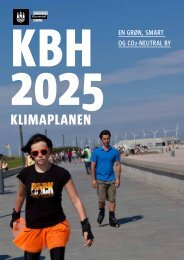
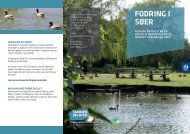
![Lokalplan 301[1] - Itera](https://img.yumpu.com/49288321/1/184x260/lokalplan-3011-itera.jpg?quality=85)
